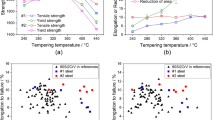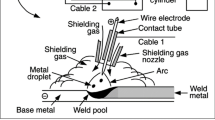Abstract
The formation of bainite in steel is generally accompanied by an enrichment in carbon of the adjacent austenite which can become remarkably stable as evidenced by its very slow transformation rate and its very lowM s point. This paper presents the results of a study of this residual austenite in an SAE-9262 steel. Both the carbon content and the amount of retained austenite have been determined as a function of transformation temperature. It has been shown that the carbon content of the enriched austenite passes through a maximum of 1.7 pct at a reaction temperature of 400°C. However, this remarkably high carbon content falls short of the one predicted by the Kinsman-Aaronson extrapolation of theA 3 curve thus indicating that the bainitic transformation cannot be considered simply as an extension of the proeutectoid transformation. In view of the inadequacy of the standard thermodynamics theory of theB s temperature, a kinetic point of view is proposed for the definition of this temperature.
Similar content being viewed by others
References
F. Wever and A. Schrader:Arch. Eisenhuettenw., 1952, vol. 23, p. 489.
R. I. Entin:The Decomposition of Austenite by Diffusional Processes, V. F. Zackay and H. I. Aaronson, eds., p. 295, Interscience, N. Y., 1962.
J. Deliry:Mem. Sci. Rev. Met., 1965, vol. 7–8, p. 524.
S. J. Matas and R. F. Hehemann:Trans. TMS-AIME, 1961, vol. 221, p. 179.
J. Pomey:Mem. Sci. Rev. Met. 1966, vol. 6, p. 509.
J. Crangle and W. Sucksmith.J. Iron Steel Inst., 1951, vol. 168, p. 141.
B. D. Cullity:Elements of X-ray Diffraction, Addison-Wesley, 1967.
D. M. Koffman and S. H. Moll:Norelco Reptr., vol. XI, no. 3, 1964, p. 95.
C. Bonnet: Laval, University, private communication.
J. M. Oblak and R. F. Hehemann:Symposium on Transformation and Hardenability in Steels, Climax Molybdenum Co., p. 15, 1967.
C. S. Roberts:Trans. AIME, 1953, vol. 197, p. 203.
G. R. Speich:The Decomposition of Austenite by Diffusional Processes, V. F. Zackay and H. I. Aaronson, eds., p. 356. Interscience, N. Y., 1962.
H. I. Aaronson:The Decomposition of Austernite by Diffusional Processes V. F. Zackay and H. I. Aaronson, eds., p. 392. Interscience, N. Y., 1962.
M. Hillert:The Decomposition of Austenite by Diffusional Processes, V. F. Zackay and H. I. Aaronson, eds, p. 197. Interscience, N. Y., 1962.
C. Zener:Trans. AIME 1946, vol. 167, p. 550.
K. R. Kinsman and H. I. Aaronson:Symposium, on transformation and Hardenability in Steels, Climax Molybdenum Co., p. 33, 1967.
H. I. Aaronson, H. A. Domian, and G. M. Pound,Trans. TMS-AIME, 1966, vol. 236, p. 753.
K. R. Kinsman and H. I. Aaronson:Symposium on Transformation and Hardenability in Steels, Climax Molybdenum Co., p. 39, 1967.
T. Ko and S. A. Cottrell:J. Iron Steel Inst., 1952, vol. 172, p. 307.
H. I. Aaronson:Decomposition, of Austenite by Diffusional Processes, V. F. Zackay and H. I. Aaronson, eds., p. 387, Interscience, N. Y., 1962.




